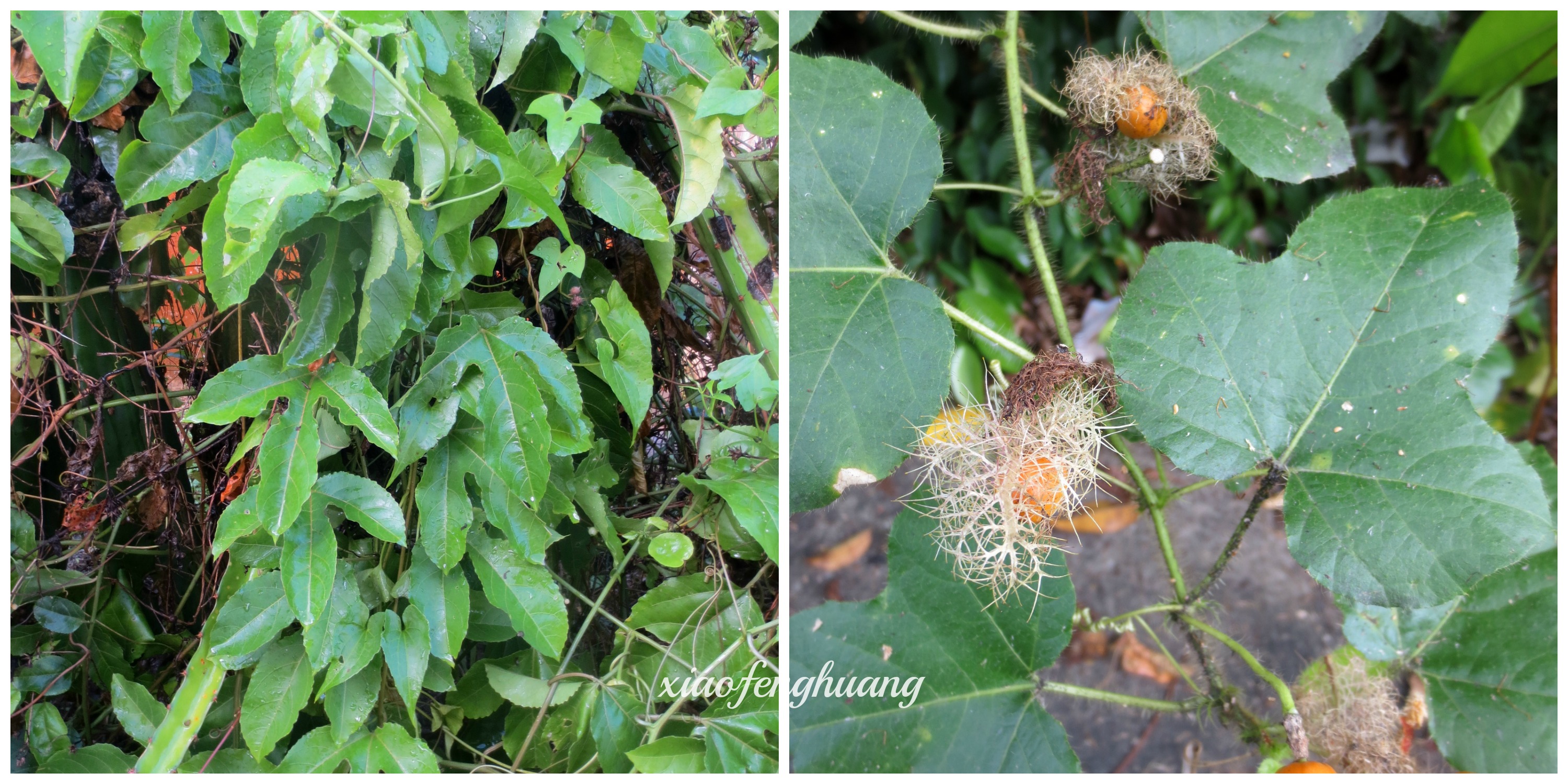Most gardeners would treat them as an invasive weed, not knowing that the fruits and young leaves are edible. It is a protocarnivorous plant meaning it can trap insects on its bracts but shows no ability to digest them.

Its flower is about 2 cm in diameter, much smaller than that of the passion fruit flower with a diameter of more or less 5 cm. Both flowers are showy and white in color with purplish streaks. Both flowers have ten white petals and a central crown of pinkish-purple filaments.
If look carefully, one can see that a letup flower has three hairy bracts underneath it.

Right- wild passion fruit vines. Notice the shapes of their leaves.
Strangely enough, their leaves are almost of the same size except the shapes are different. Both leaves are three-lobed except that the passion fruit leaves are thicker and more deeply lobed.
Both are woody climbers for older plants but letup leaves and stems are covered in soft hair. The mini fruits are enclosed in hairy net. Green letup fruit is a bit sour while the ripe one with orange skin is sweet. I recall memories of my primary school years – standing alone in the bush, eating those ripe fruits of letup, unaware of the danger of snake bites. The juicy pulp of the fruits are very sweet, good for quenching thirst in the hot afternoon.

The unripe fruits enclosed in hairy net are dark green in color. The seeds inside are not mature yet and there is no juicy pulp inside. The white and undeveloped seeds in the green fruits taste slightly sour. Birds love the ripe letup fruits. Very often, these fruits are finished by the birds before they are ready for harvest.

Letup fruit with a diameter of 1-1.5 cm, is much smaller than the passion fruit. Green letup fruit is a bit sour and the ripe one with orange skin is sweet as compared to the passion fruits, the pulp of which is juicy but tastes sour. Both pulp and seeds are edible.
The passion fruit juice is a common drink and the pulp is used as topping on ice cream and cakes whilst the letup juicy pulp, though sweet, is not suitable for commercial purpose due to its small fruit size.
 Letup shoots collected from empty land. Notice the hairy stems and leaves.
Letup shoots collected from empty land. Notice the hairy stems and leaves.The letup shoots are edible. All parts of the plant are covered in soft hair, stems and leaves likewise, hence the name, Hairy passiflora. Notice the tendrils for climbing. Letup shoots contain a lot of potassium, 660 gm per unit. Click Table 2 to find out.
In Vietnamese folk medicine, dry letup leaves are used in tea to relieve sleeping problem. In Chinese medicine, it is used to treat skin disease. Boil the whole plant in water and wash the affected area or mash the leaves and apply on the affected area. It is a good remedy for leg ulcer.
 Washing letup shoots in the water. Look at the bubbles formed due to presence of saponins.
Washing letup shoots in the water. Look at the bubbles formed due to presence of saponins.
How to prepare letup ?
The picture above shows that letup shoots produce bubbles in the water. Continuous rinsing is necessary until there is no bubbles left. Failure to do this rinsing step will result in very bitter dish. We learn this from our native friends and one of my facebook friend, Polly Steven who is an Iban herself, did describe this rinsing step in detail. The bubbles are due to its high level of saponins.
“Saponins are glycosides with a distinctive foaming characteristic. They are found in many plants. Saponins are bitter and therefore reduce the palatability of livestock feeds. The ability of a saponin to foam is caused by the combination of the nonpolar sapogenin and the water soluble side chain.” – source from the net.
Drain the shoots after thorough rinsing. Crush the shoots with hands followed by chopping finely the shoots. Do not thrown away the green juice which is full of chlorophyll.
Recipe
Stir-fry letup shoots
Ingredients
- 300 g letup shoots
- 1 telur tebu(sugar cane flower) – chopped finely
- or
- 200 g baby corn( chopped finely)
Method
- Prepare the shoots as described above.
- Stir fry the shoots with chopped telur tebu.
- Add 2 tsp of light soy sauce.
- Add in the green juice too. It tastes like cangkok manis and longbean shoots mixed. It is slightly bitter, a perfect choice for lei cha side dish. One can easily get addicted to it.
Don’t forget its dry leaves can be used in tea and is a remedy for insomnia but make sure to wash all the bubbles or saponins away.
Letup, a weed to some gardeners,
a delicious vegetable
and an useful herb to others.
Copyright claim – Do not crop any pictures from malaysiavegetarianfood.com.Do not share our pictures without any watermarked signature on them.Excerpts from our articles to be credited to malaysiavegetarianfood.com.

